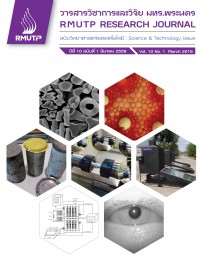ผลของระดับอุณหภูมิในการอบแห้งถ่านอัดแท่งด้วยเครื่องอบแห้งพลังงานแสงอาทิตย์ร่วมกับรังสีอินฟราเรดไกล และเครื่องอบแห้งรังสีอินฟราเรดไกล
Main Article Content
Abstract
บทคัดย่อ
งานวิจัยนี้มีวัตถุประสงค์เพื่อศึกษาถึงผลของระดับอุณหภูมิอบแห้งต่อการเปลี่ยนแปลงความชื้นของถ่านอัดแท่งระหว่างการอบแห้งด้วยพลังงานแสงอาทิตย์ร่วมกับรังสีอินฟราเรดไกล และการอบแห้งด้วยรังสีอินฟราเรดไกลเพียงอย่างเดียว รวมทั้งหาปริมาณไฟฟ้าและความสิ้นเปลืองพลังงานจำเพาะที่ใช้ในการอบแห้ง โดยอบแห้งถ่านอัดแท่งจากกะลามะพร้าวซึ่งมีความชื้นเริ่มต้นประมาณ 41-43% มาตรฐานเปียก ที่อุณหภูมิ 55, 60 และ 65oC จนความชื้นของถ่านอัดแท่งต่ำกว่า 8% มาตรฐานเปียก ผลการทดลองพบว่า ระดับอุณหภูมิอบแห้งและวิธีการอบแห้งมีผลต่อการเปลี่ยนแปลงความชื้นของถ่านอัดแท่ง โดยการอบแห้งที่อุณหภูมิสูงสามารถลดความชื้นของถ่านอัดแท่งได้เร็วกว่าการอบแห้งที่อุณหภูมิต่ำ และการอบแห้งด้วยรังสีอินฟราเรดไกลเพียงอย่างเดียวสามารถลดความชื้นของถ่านอัดแท่งได้เร็วกว่าการอบแห้งด้วยพลังงานแสงอาทิตย์ร่วมกับรังสีอินฟราเรดไกล นอกจากนี้ยังพบว่า ปริมาณไฟฟ้าและความสิ้นเปลืองพลังงานจำเพาะที่ใช้ในการอบแห้งมีค่าลดลงเมื่อระดับอุณหภูมิอบแห้งสูงขึ้น การอบแห้งด้วยพลังงานแสงอาทิตย์ร่วมกับรังสีอินฟราเรดไกลมีปริมาณไฟฟ้าที่ใช้ในการอบแห้งน้อยกว่า แต่มีความสิ้นเปลืองพลังงานจำเพาะมากกว่าการอบแห้งด้วยรังสีอินฟราเรดไกลเพียงอย่างเดียว ทั้งนี้ถ่านอัดแท่งในงานวิจัยนี้มีค่าความร้อนเฉลี่ยประมาณ 6,667.05 แคลอรีต่อกรัม
Abstract
This research aims to study the effect of drying temperature on the changes in the moisture content of charcoal briquettes undergoing drying of solar energy and far-infrared radiation (Solar+FIR), and far-infrared radiation (FIR). The electricity consumption and the specific energy consumption were also investigated. The coconut shell charcoal briquettes with the initial moisture content of about 41-43% MW were dried at 55, 60 and 65oC until the final moisture content of 8% MW was obtained. Based on the experimental results, it was found that the drying temperatures and the drying methods had effects on the changes in the moisture content of charcoal briquettes. Drying at high temperature could reduce the moisture content of charcoal briquettes faster than that at low temperature. Drying using FIR could reduce the moisture content of charcoal briquettes faster than that using Solar+FIR. Moreover, the electricity consumption and the specific energy consumption decreased with an increase in the drying temperature. Drying using Solar+FIR had lower electricity consumption, but had higher specific energy consumption than drying using FIR. In this study, the charcoal briquettes had the average heating value of about 6,667.05 cal/g.


